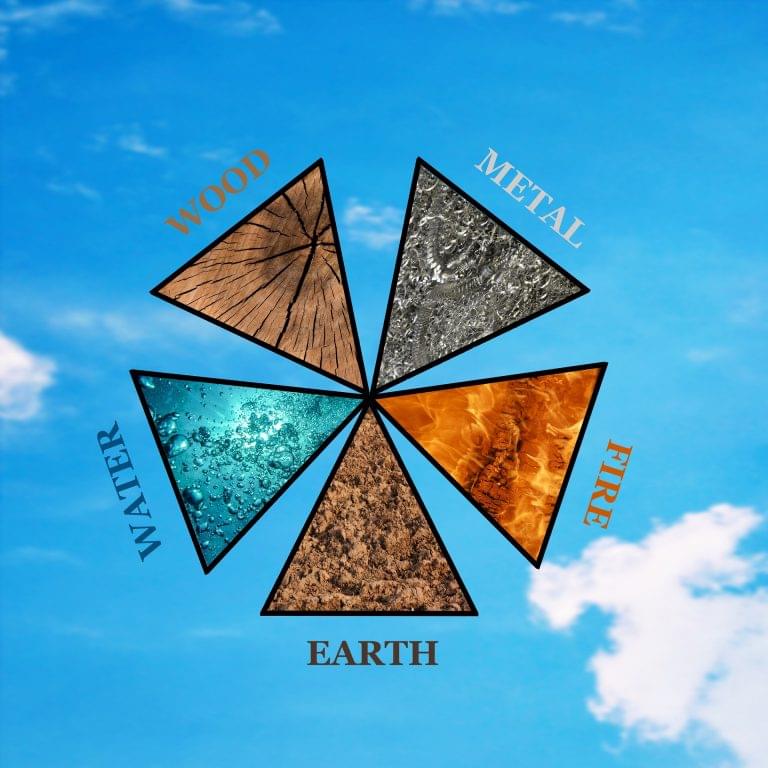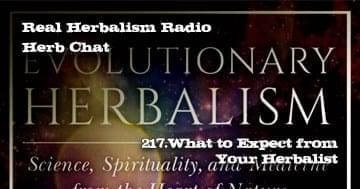There is an expression that you are the average of the five people you spend the most time with. I find this mildly terrifying because my top five includes my cat, who likes to poop on my bed and eat dental floss. I shudder to imagine what it means if my cat makes up one-fifth of my personality.
Chinese medicine has a similar theory that involves less cross-species personality invasion. Instead of five people, there are five elements. These five elements are present in every person, and health is produced when the elements are in balance. Every element has a cardinal direction, color, flavor and emotion, along with many other correspondences that can be stretched to include all matter in the universe. This subject has been written about by practitioners of Chinese medicine and Chinese philosophers for centuries, and you could fill enormous volumes with all the ideas around the five elements.
Here, I am going to go over each element very briefly, and focus on the ways that understanding these elements can be practical.
First, it’s important to note that the use of the word “element” is a bit misleading. In English, the word “element” means the fundamental building blocks of matter, unchanging and unchangeable. The Chinese term “xing” (行) is better understood as “phase.” In five element theory it is understood that all matter passes through each of these five phases at different times. These are not static components, they are dynamic states of being.
The five elements are Earth, Metal, Water, Wood, and Fire.
Earth Phase: Your Elemental Center
Earth is the center of everything. Each element is associated with a cardinal direction (North, South, East, West), but Earth is the center.
The color of Earth is yellow. This may be because in the Yellow River Valley, which is the cradle of Chinese civilization, the soil itself has a yellowish hue due to rich silt deposits that make the soil very fertile.
The flavor of Earth is sweet. These theories developed long before Chinese people were introduced to sugar, so the “sweetness” described here is the sweetness of fruits and even the mild sweetness of rice, not necessarily the overpowering sugary goodness of a 7-Eleven slurpee.
The organs associated with the Earth are the Spleen and the Stomach.
Note: The Spleen in Chinese medicine is conceived of very differently than in Western medicine. Some modern theorists have argued that the organ referred to in Chinese as Pi (脾) more closely resembles the pancreas than the anatomical spleen. However, early Chinese anatomists were aware of the existence of the pancreas, referred to it as Yixian (胰腺) and did not consider it to be of much importance.
Just as the Earth nourishes plants, so these two digestive organs help to nourish our bodies by processing our food.
The Earth is also connected to the Yi, or the intellect, and it governs our capacity for abstract thought. The Earth helps us “digest” ideas the same way it digests our food. If you are in college or working in a job that requires high-level analysis – you are using your Yi.
The emotion of Earth is worry, which is related to Yi. The positive aspects of being good at thinking can turn against you when it becomes obsessive rumination, over-thinking and over-analyzing. This is like chewing your food over and over again, but never swallowing. What was once a healthy practice, when taken to an extreme, is damaging.
Metal Phase: Me vs. Not-Me
The key to understanding the Metal element is that it is all about borders and boundaries. Where do I end and the rest of the world begins? What is me, and what is you? How do I see myself? How am I seen by others?
Just as we can see ourselves reflected back in a shiny metal surface, so too does the Metal element reflect our self-identity.
The color of Metal is white and it is associated with the West and the setting sun.
The flavor of Metal is often translated as “pungent.” This is not a word I use in my daily life, so I didn’t find that very helpful. Carola Beresford-Cooke described it as a flavor “with a ‘bite’ to reawaken the senses, such as garlic, strong cheese or the hot taste of cayenne or chili.”
The organs associated with Metal are the Lung and the Large Intestine. The Lung brings energy in to the body through breathing, and the Large Intestine gets rid of waste products. Metal governs our ability to take what we need and discard what we don’t need. Being able to give without being drained; and being able to receive without being overwhelmed. It’s tricky. And it is not uncommon for the Metal to get thrown out of balance, frequently causing respiratory symptoms such as asthma, shortness of breath, and wheezing or, in relation to the Large Intestine, constipation with dry stool.
Just as the Earth is associated with the Yi, the Metal is associated with the Po. The Po is the “corporeal soul,” the soul of the body. It is connected with bodily sensations and our ability to respond appropriately to those sensations. Allergies are an example of the failure of the Metal element because the body is over-reacting to a stimulus. A person who gets frequent colds is also suffering from a Metal failure, this time with the body under-reacting to a stimulus.
The emotion of Metal is grief. As Metal is responsible for what the person takes in from the universe, it is the hardest hit by loss. The ability to cope with loss without becoming afraid to connect with others is a sign of a healthy Metal element.
Water Phase: Diving Deep into the Darkness
“Calm waters run deep” is the heart of the Chinese medicine view of the Water element. It represents the deepest aspects of ourselves, the most primal instincts, our ancestral knowledge. And in these deep waters lurk monsters.
The color of Water is black, like a frozen pond in the middle of the night in the dark of winter. Water is associated with the North. In Chinese cosmology, the North is the source of cold, and the South is the origin of heat. If you look at where China is located geographically, this makes sense. Anyone who has experienced the Siberian winds blowing into Beijing has felt the cold coming from the North.
The flavor of Water is salty, like the ocean. In herbal medicine, the salty flavor is believed to have the ability to “soften hardness,” as the ocean eventually erodes mountains. Salty herbs, like seaweed, are thus often given to treat conditions that involve lumps, nodules or tumors.
The organs associated with Water are the Kidneys and the Bladder. Both deal with water metabolism and the flow of water through and out of the body.
Water is the element of the Zhi, or the Will, as in “the will to survive.” This is the part of you that kicks in when facing down a tiger, or pushing yourself through to end of a marathon. When your Will is strong, you can fight through difficult obstacles and come out swinging.
The emotion of the Water element is fear. Fear directly engages the Will. Fear is the primal feeling that your safety is under threat. A healthy Will allows you to overcome fear.
When the Will is weak, however, and the fear overtakes you–what happens? It damages the Kidneys and the Bladder and they can no longer function correctly. This is why people in the grips of intense fear will lose urinary control and wet themselves. The Water element is then clearly out of balance.
Wood Phase: Growing Up and Outward
This is my favorite element. Wood is all about growing, creativity, upward and outward energy. Wood is the power that tree roots have when they displace concrete. Wood is the exciting energy of the springtime. Wood is the thrill you get when something you planted starts to grow.
The color of Wood is green, and it is associated with the East, the hopeful energy of the sunrise.
The flavor of Wood is sour, which is another reason why I love it. I could eat sour foods all day. Pickles, lemons, pomegranates – you name it!
The organs associated with Wood are the Liver and Gall Bladder. In Chinese medicine, the Liver is responsible for the circulating of Blood and Qi throughout the body. The energy goes in all directions–like a wildly growing ivy vine.
On the spiritual side, Wood is associated with the Ethereal Soul, or the Hun, which is housed in the Liver. The Ethereal Soul is the one that continues after the death of the body. The Corporeal Soul, associated with Metal and housed in the Lung, dies with the body.
The Hun may live in the Liver, but it likes to travel. At night, it is the wandering of the Hun that gives us our dreams. A healthy Wood element allows our Hun to have wonderful journeys at night, and return safely to our Liver before we awake in the morning. Disturbance of the Wood element leads to nightmares and insomnia.
The emotion of Wood is rage. When the creative drive is suppressed, that energy gets backed up in to the Liver and turns in to heat. That heat blazes upwards, causing red faces and shouting voices. Any unexpressed emotion or stifled creative impulse damages the Liver, and damage to the Liver makes it harder to express oneself creatively.
Creativity and anger are both forces that can be disruptive. The work of great artists like Diego Rivera and Frida Kahlo illustrate how creativity and social disruption can walk hand in hand.
Anger is so frequently associated with social disruption that it is often actively repressed. From early ages children are taught not to yell, stomp their feet, talk back–not to get angry. Women even more than men are told that there is no place in this world for their anger. They need to “be nice,” as though anger was essentially unkind.
But anger is a natural emotion that, when kept in proper balance with worry, grief, fear, is absolutely part of this complete breakfast. Giving voice to your anger is part of the healthy functioning of the Liver and the Wood element.
Remember: telling someone that you are angry at them and why is not a harmful act. It is not necessarily damaging or even socially disruptive (and some social situations need to be disrupted). Repressing your anger until it builds up and overwhelms you–that is a harmful act.
So love your Wood energy! Love your Liver! Love your anger, even. And let it serve you.
Fire Phase: Setting the World Ablaze with Joy
Fire is like it sounds. Its energy burns upward, blazes up quickly and dies down quickly. You know you’re talking to a Fire-type person if you find yourself getting scorched.
The color of fire is Red and it is associated with the South. Because China is located in the northern hemisphere, the sun is seen in the South and heat comes from the South, just as cold blows down from the North.
The flavor of Fire is bitter, like the after-taste of char.
In terms of organs, Fire is a bit of a double element, representing 4 organs instead of the usual two. The Heart, Small Intestine, Pericardium and Triple Heater are all associated with Fire.
The spirit of Fire is called Shen, and can be understood as “awareness.” A person with “good Shen” has sparkle in their eyes, they know where and who they are, make healthy eye contact, and can answer questions appropriately. A person with “shen disturbance,” has dull eyes, their eyes either stare unblinking into space or they dart about in constant movement; the person speaks incoherently; is disoriented and easily confused. Shen disturbance is a whole field of Chinese medicine and it all relates to Fire dysfunction. Either the Fire is burning so hot that the Shen cannot rest, or the Fire has burned out and the Shen is deprived of the animating principle.
The emotion of Fire is joy. When we say that something “warms our heart,” it is evoking in us that sense of joy, which, not coincidentally, comes with a feeling of warmth and ease.
So now you have met your five best friends, and you are the average of all five. There is some of each of these in you (maybe one more than the others), and keeping them all balanced and in harmony with each other is what leads to good health and a long life.






